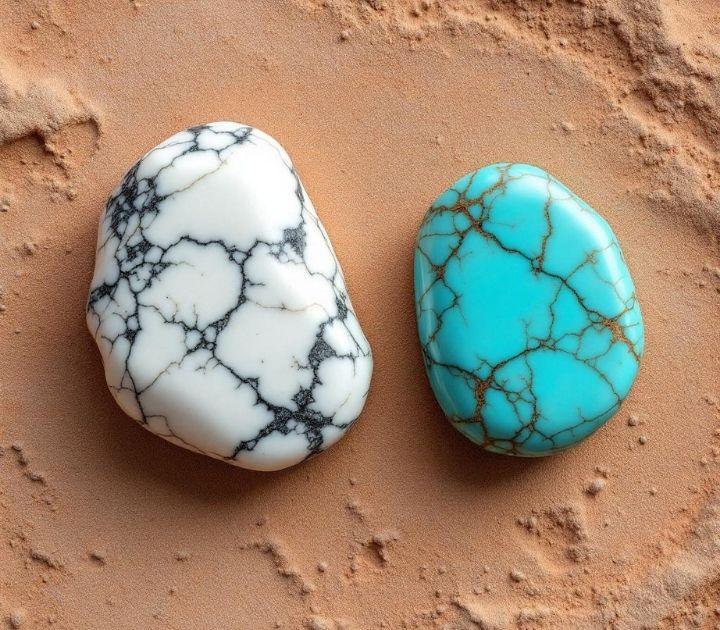Our Latest Articles
Notes from the bench side of Santa Fe—stone guides, styling ideas, and maker spotlights.

White Buffalo vs. Turquoise: What’s the Real Difference?

White Buffalo and turquoise — two stones, one Southwest mystique.
To the untrained eye, they might seem like cousins—both bold, both beautiful, both beloved by collectors and artists.
But dig a little deeper, and you’ll discover they’re as different as desert and snow.
Whether you’re a seasoned jewelry lover or just starting your collection, knowing the difference isn’t just about trivia—it’s about making smart, joyful choices for your style and your story. Let’s break it down, bust the myths, and help you fall in love with both.
What Is Turquoise, Really?
Turquoise is the Southwest’s signature stone—an opaque mineral ranging from sky blue to deep green, often streaked with a spiderweb of matrix lines.
Composition: Hydrated phosphate of copper and aluminum
Origins: Found across the American Southwest (Arizona, Nevada, New Mexico), with each mine producing unique colors and patterns
History: Prized for centuries by Native American artists, royalty, and collectors worldwide

What Makes Turquoise Special
Every stone is unique—no two are ever alike.
It’s the heart of many Southwest jewelry traditions.
Believed to bring protection, luck, and a sense of grounded confidence.
What Is White Buffalo?
White Buffalo, often called “White Buffalo turquoise” (though it’s not actually turquoise), is a striking white stone with dramatic black or brown matrix.
Composition: A form of calcite, sometimes with dolomite; not a phosphate, so not technically turquoise
Origins: Found primarily in Nevada, especially the Tonopah region
History: Discovered only in the late 20th century, it’s quickly become a collector favorite for its graphic look and rarity

What Makes White Buffalo Special
That high-contrast, graphic matrix—bold, modern, and versatile
Rarity: Only a few mines produce true White Buffalo, making quality stones highly sought after
It pairs beautifully with both silver and gold, and looks stunning on all skin tones
Key Differences: White Buffalo vs. Turquoise

Why Collect Both?
Contrast: The pairing of vivid turquoise and stark White Buffalo is a collector’s dream—classic Southwest with a modern twist.
Versatility: White Buffalo is the ultimate neutral; turquoise brings the pop.
Collectibility: Both are highly prized, especially when set by known artists and hallmarked.
How to Tell Them Apart (Even If You’re a Newbie)
Color: Turquoise is never true white; White Buffalo is never blue or green.
Matrix: Turquoise matrix can be brown, black, or golden, but the stone itself is always colored. White Buffalo’s matrix is bold and web-like.
Feel: Both are durable, but White Buffalo may feel slightly softer due to its calcite base.
Seller’s Description: Reputable shops (like Wildflower) will always clarify which stone you’re getting.
Styling Tips: White Buffalo and Turquoise
Mix and match: Don’t be shy—layer turquoise and White Buffalo for a modern, curated look.
Pair with neutrals: White Buffalo loves sand, black, camel, and denim. Turquoise pops against white, navy, and earth tones.
Contrast textures: Smooth White Buffalo next to a chunky turquoise cuff? Chef’s kiss.
Everyday or statement: White Buffalo rings are graphic and bold; turquoise pendants are timeless and easy.

How Artists Use Each Stone
Turquoise: Often in channel inlay, bead necklaces, classic cuffs, and rings. Artists like Johnny Coonsis and Rick Tolino are known for their turquoise mastery.
White Buffalo: Favored for statement rings, split-shank cuffs, and pendants. Look for hallmarks from artists like Leslie Yazzie and SE.
FAQs
Question 1: Is White Buffalo more valuable than turquoise?
Answer: It depends on quality, size, and artistry. Top-grade stones of both can command high prices, especially in artist-signed pieces.
Question 2: Is White Buffalo turquoise?
Answer: Nope! It’s a calcite mineral, not a phosphate. The “turquoise” label is a marketing shortcut—but not technically correct.
Question 3: Can I wear both stones together?
Answer: Absolutely! The contrast is modern, graphic, and totally Southwest.
Question 4: How do I care for White Buffalo and turquoise jewelry?
Answer: Wipe with a soft cloth, avoid chemicals, and store dry. Both stones are durable but can be scratched by harder materials.
Real Collector Stories
White Buffalo and turquoise—different stones, same Southwest soul. Why not both?
Whether you’re drawn to the vivid blues of turquoise or the bold contrast of White Buffalo, Wildflower curates only the real deal—artist-made, ethically sourced, and always authentic.

Elegant Guidance
Our Promise, Your Peace of Mind
Every piece is chosen for quality, authenticity, and care—so you can shop with confidence.
Be First in Line
Get early access to drops, private previews, and member-only offers.
Because the best pieces don’t wait around.
Always Sterling Silver
Authentic Turquoise Only
Makers Credited & Celebrated
Fast, Reliable Shipping
Easy, Hassle-Free Returns

